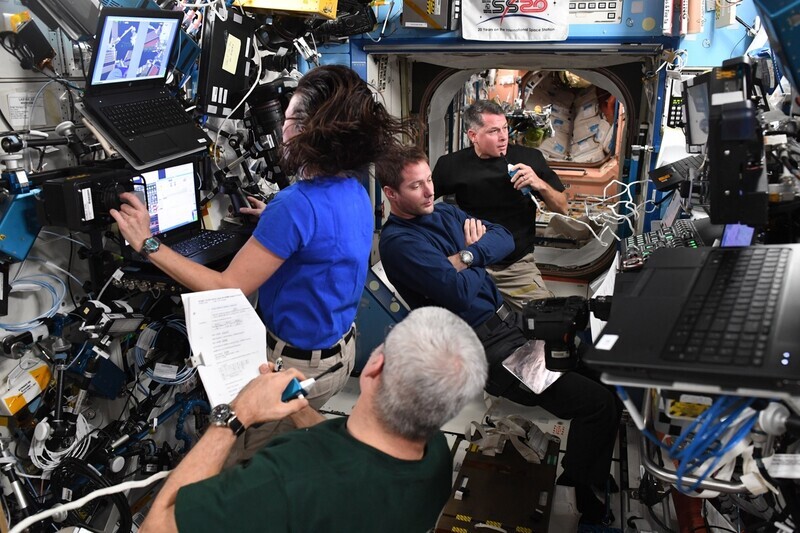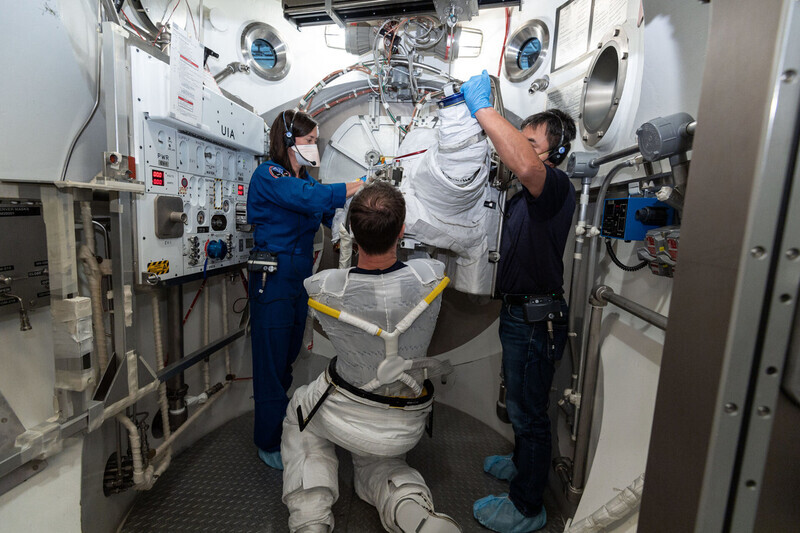hankyoreh
Links to other country sites 다른 나라 사이트 링크
Here’s what astronauts do when their clothes get dirty in space

What do astronauts do with the clothes they’ve been wearing all day? Here’s the answer: they wear it again the next day.
Since you can’t just run the laundry in space, astronauts keep wearing their clothes until they’re filthy and then put them in the receptacle.
Clothing does stay clean a little longer in space than it would on earth. Less energy is expended in zero gravity, which means that astronauts don’t sweat as much.
The length of time that astronauts wear clothing depends on the category: underwear, socks, gym clothes and work clothes.
According to NASA, astronauts need 150 pounds of clothing for each year in space. Astronauts would need three times that much for a round trip to Mars, which would take three years. The old clothing is stored in cargo ships that burn up during atmospheric reentry.
But wearing clothes until they get grubby is one of the downers about spending time in space. The length and frequency of space travel will keep increasing in the future, and a permanent base may be built on the moon someday – two reasons why the current approach to space duds isn’t sustainable.

NASA wants to rectify this costly and inefficient practice, so it has partnered with Procter & Gamble, the manufacturer of lifestyle goods, to find a way to wash clothing in space and enable continued wear.
The organization was looking into special antimicrobial clothing, but eventually concluded that that wasn’t a long-term solution.
Astronauts on the space station currently need to exercise two hours a day in zero gravity so they don’t lose bone and muscle mass. This exercise leaves underwear drenched in sweat – and smelly, too.
Former NASA astronaut Leland Melvin, spokesperson for the project, told the Associated Press that “t-shirts, shorts, and socks end up so foul that they run through a pair every week.”
“After that, they’re deemed toxic,” Melvin said. “They’re so stiff from all that sweat.”
This December, Procter & Gamble plans to send up Tide powder detergent it has developed for use in space and see whether the detergent functions properly in zero gravity over six months. Then in May 2022, the company will also send up stain remover pens and wet wipes for astronauts to try out.
Procter & Gamble plans to run an equivalent and simultaneous experiment on the same ingredients back on earth to see whether the detergent functions differently in the two environments.

Finding a way to wash clothes in space would reduce garbage and save money by cutting down on the cost of purchasing and transporting clothing. The cost of clothing a single astronaut for one year is about US$1.6 million.
Procter & Gamble is also developing a combo washer dryer that will operate on detergent and a minimal amount of water. If successful, the technology could also be put to good use in dry parts of the planet.
But there’s one obstacle to developing a washer dryer for space: the laundry water would have to be recycled, just as astronauts’ sweat and urine is.
By Kwak No-pil, senior staff writer
Please direct comments or questions to [english@hani.co.kr]

Editorial・opinion
![[Column] Season 2 of special prosecutor probe may be coming to Korea soon [Column] Season 2 of special prosecutor probe may be coming to Korea soon](https://flexible.img.hani.co.kr/flexible/normal/500/300/imgdb/original/2024/0426/3317141030699447.jpg) [Column] Season 2 of special prosecutor probe may be coming to Korea soon
[Column] Season 2 of special prosecutor probe may be coming to Korea soon![[Column] Park Geun-hye déjà vu in Yoon Suk-yeol [Column] Park Geun-hye déjà vu in Yoon Suk-yeol](https://flexible.img.hani.co.kr/flexible/normal/500/300/imgdb/original/2024/0424/651713945113788.jpg) [Column] Park Geun-hye déjà vu in Yoon Suk-yeol
[Column] Park Geun-hye déjà vu in Yoon Suk-yeol- [Editorial] New weight of N. Korea’s nuclear threats makes dialogue all the more urgent
- [Guest essay] The real reason Korea’s new right wants to dub Rhee a founding father
- [Column] ‘Choson’: Is it time we start referring to N. Korea in its own terms?
- [Editorial] Japan’s rewriting of history with Korea has gone too far
- [Column] The president’s questionable capacity for dialogue
- [Column] Are chaebol firms just pizza pies for families to divvy up as they please?
- [Column] Has Korea, too, crossed the Rubicon on China?
- [Correspondent’s column] In Japan’s alliance with US, echoes of its past alliances with UK
Most viewed articles
- 1Samsung subcontractor worker commits suicide from work stress
- 2‘We must say no’: Seoul defense chief on Korean, USFK involvement in hypothetical Taiwan crisis
- 3[Editorial] Korea’s surprise Q1 growth requires objective assessment, not blind fanfare
- 4No good, very bad game for Korea puts it out of Olympics for first time since 1988
- 5Division commander ordered troops to enter raging flood waters before Marine died, survivor says
- 6N. Korean delegation’s trip to Iran shows how Pyongyang is leveraging ties with Moscow
- 7Korea’s 1.3% growth in Q1 signals ‘textbook’ return to growth, says government
- 8US overtakes China as Korea’s top export market, prompting trade sanction jitters
- 9[Column] Park Geun-hye déjà vu in Yoon Suk-yeol
- 10[Column] Season 2 of special prosecutor probe may be coming to Korea soon